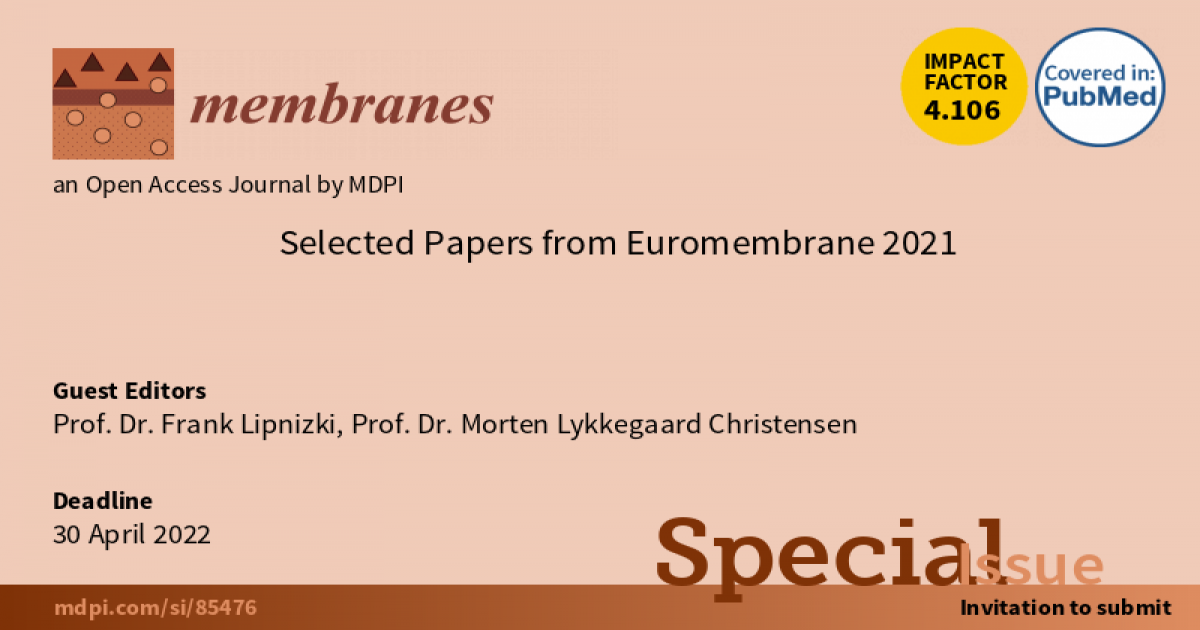Selected Papers from Euromembrane 2021
A special issue of Membranes (ISSN 2077-0375).
Deadline for manuscript submissions: closed (30 April 2022) | Viewed by 34444

Special Issue Editors
Interests: membrane separation processes; integration of membrane processes; fouling and cleaning; membrane applications in food, biotech and chemical industry; water and wastewater treatment
Special Issues, Collections and Topics in MDPI journals
Interests: characterisation, flocculation and separation of organic waste streams (wastewater, manure etc); matematical modeling of filtration and dewatering processes based on feed charateristic and colloidal chemistry; membrane filtration for water purification; water reuse and recovery of nutrients e.g. MBR; MF/UF systems and forward osmosis
Special Issue Information
Dear Colleagues,
We are very happy to announce that Lund University (Sweden) and Aalborg University (Denmark) will jointly host Euromembrane 2021 in Copenhagen (Denmark). This is the first time that this important membrane event will be hosted in Scandinavia.
The dates for Euromembrane in Copenhagen are 28 November–02 December, 2021. The location is the Tivoli Hotel and Congress Centre in the heart of Copenhagen, in walking distance to the Main Station, Tivoli park, the National Museum and the Town Hall. The Tivoli Hotel and Congress Centre is an ideal place to bring together academic and industrial scientists in the field of membrane science and technology. On top of this, the participants will have the opportunity to experience Scandinavian hospitality first hand.
This Special Issue, “Selected Papers from Euromembrane 2021”, will contain papers presented during the Euromembrane conference. On behalf of the organizing committee, we cordially invite you to join us. Participants of the conference are cordially invited to contribute original research papers or reviews to this Special Issue of Membranes.
We looking forward to meeting you in Copenhagen.
Note: 25% discount on APC will be offered to all the Euromembrane 2021 conference Participants!
Prof. Dr. Frank Lipnizki
Prof. Dr. Morten Lykkegaard Christensen
Guest Editors
Manuscript Submission Information
Manuscripts should be submitted online at www.mdpi.com by registering and logging in to this website. Once you are registered, click here to go to the submission form. Manuscripts can be submitted until the deadline. All submissions that pass pre-check are peer-reviewed. Accepted papers will be published continuously in the journal (as soon as accepted) and will be listed together on the special issue website. Research articles, review articles as well as short communications are invited. For planned papers, a title and short abstract (about 100 words) can be sent to the Editorial Office for announcement on this website.
Submitted manuscripts should not have been published previously, nor be under consideration for publication elsewhere (except conference proceedings papers). All manuscripts are thoroughly refereed through a single-blind peer-review process. A guide for authors and other relevant information for submission of manuscripts is available on the Instructions for Authors page. Membranes is an international peer-reviewed open access monthly journal published by MDPI.
Please visit the Instructions for Authors page before submitting a manuscript. The Article Processing Charge (APC) for publication in this open access journal is 2200 CHF (Swiss Francs). Submitted papers should be well formatted and use good English. Authors may use MDPI's English editing service prior to publication or during author revisions.
Keywords
- Microfiltration/ultrafiltration
- Nanofiltration/reverse osmosis
- Forward osmosis/pressure retarded osmosis
- Organic solvent nanofiltration
- Membrane reactors
- Membrane bio-reactors
- Membrane contactors and membrane distillation
- Gas separation
- Pervaporation and vapor permeation
- Electro-membrane processes
- Membrane emulsification
- Membrane fouling and cleaning
- Transport models
- Fluid dynamics
- Module design
- Fuel cells
- 3D printing of membranes
- Novel membrane materials
- 1D and 2D materials for membranes
- Inorganic membranes
- Biomimetic and bioinspired membranes
- Aging of polymeric membranes
- Advanced fabrication methods
- Facilitated transport membranes
- New characterization methods
- Environmental applications
- Industrial applications and scale-up
- CO2 capture
- Bio-separations and bio-refinery
- Bio-medical applications
- Drinking water
- Wastewater treatment
- Pharmaceuticals and biotechnology
- Food processing
- Paper and pulp industries
Benefits of Publishing in a Special Issue
- Ease of navigation: Grouping papers by topic helps scholars navigate broad scope journals more efficiently.
- Greater discoverability: Special Issues support the reach and impact of scientific research. Articles in Special Issues are more discoverable and cited more frequently.
- Expansion of research network: Special Issues facilitate connections among authors, fostering scientific collaborations.
- External promotion: Articles in Special Issues are often promoted through the journal's social media, increasing their visibility.
- e-Book format: Special Issues with more than 10 articles can be published as dedicated e-books, ensuring wide and rapid dissemination.
Further information on MDPI's Special Issue policies can be found here.







